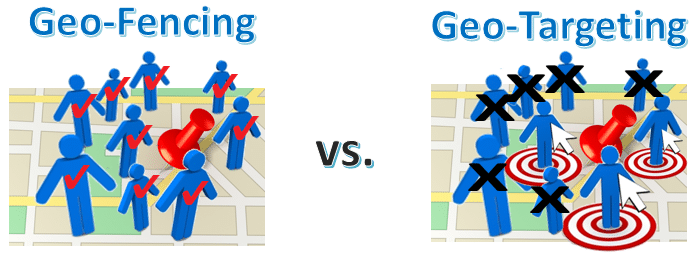Geo-Fencing and Geo-Targeting: What’s the Difference? (Example)
Digital jargon can be pretty confusing at times. Many words can have different meanings and it’s important to dig further into their true definitions. For example, keyword targeting could mean Pay-Per-Click, organic keyword display, or can even mean targeting keywords on your website to increase a websites SEO value. See what I mean? Confusing!
Most often confused? GEOs! I often hear the terms geo-fencing and geo-targeting used interchangeably but they are not the same product and should be used differently in digital marketing campaigns. Let’s first start with their true definitions.
Geo-Fencing refers to drawing a virtual barrier around a location using your devices global positioning system (GPS) or Internet Protocol (IP) address, which is just like your virtual address. Ads inside of geo-fenced areas can be seen on computer, tablet, or mobile devices as potential customers are browsing the web. Technically, geo-fencing can be any size radius from a particular location, anywhere from a mile to state-wide. But most people when they are referring to geo-fencing are looking for a very tight radius around a location. A misconception with geo-fencing is that once inside the fence you receive push notifications, or text messages to the device, which is not accurate. What geo-fencing does instead is show ads to the person inside the geo-fenced radius if they are browsing the web, to alert them of a local deal or the distance you are from a particular store location.
So how is geo-targeting different? Geo-targeting refers to delivering ads to people meeting a specific targeting criteria and who enter inside of a defined radius using the same geo-fencing location technology. The key difference is geo-targeting hones in on specific consumer targeting criteria like demographics, behaviors, interests, as well as where the person is located. You often need bigger geos to do this since you are not showing the ads to EVERYONE inside the geo-fence, they must also meet the targeting criteria.
Both geo-fencing and geo-targeting can be done on mobile, tablet, computer, or even gaming devices with internet access. When it comes to deciding which is best for your marketing, think of who your target customer is. If you are interested in advertising to a population of all ages and all interests, geo-fencing is perfect for you. If you are only interested in hitting only a specific consumer demographic that is more niche, then you should be doing geo-targeting.







